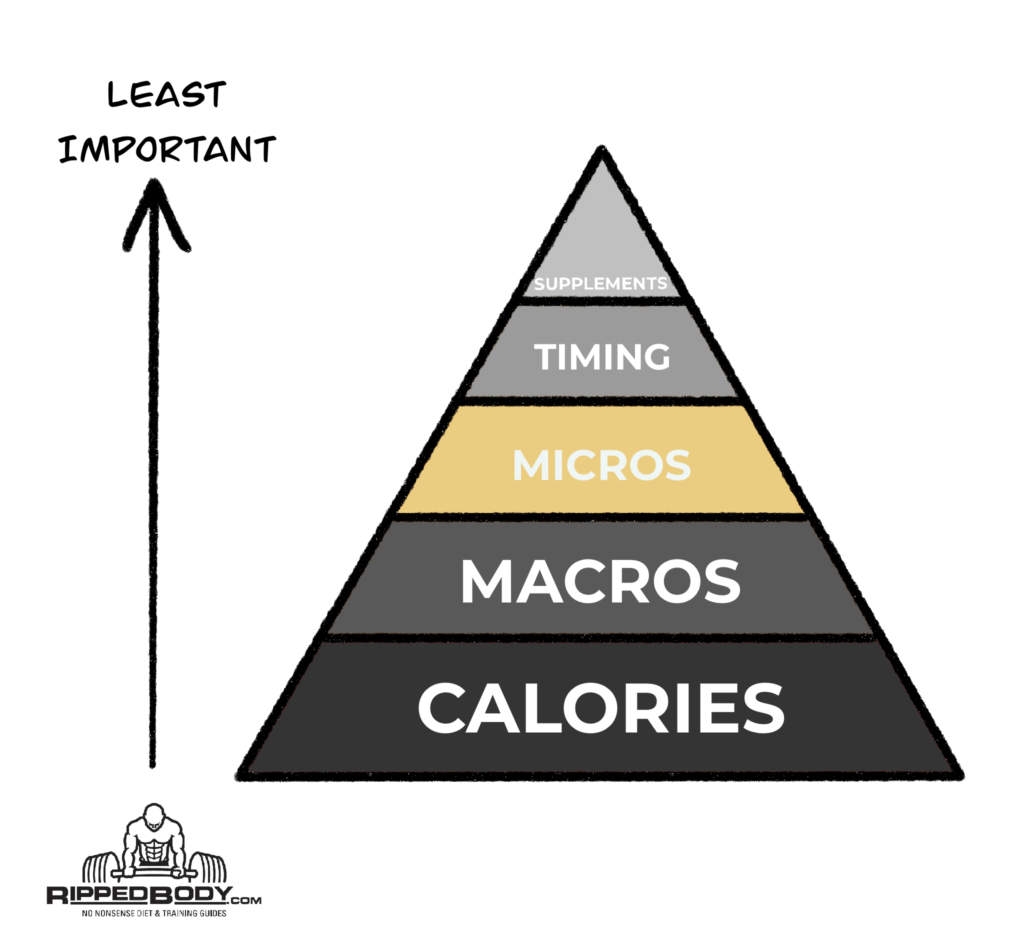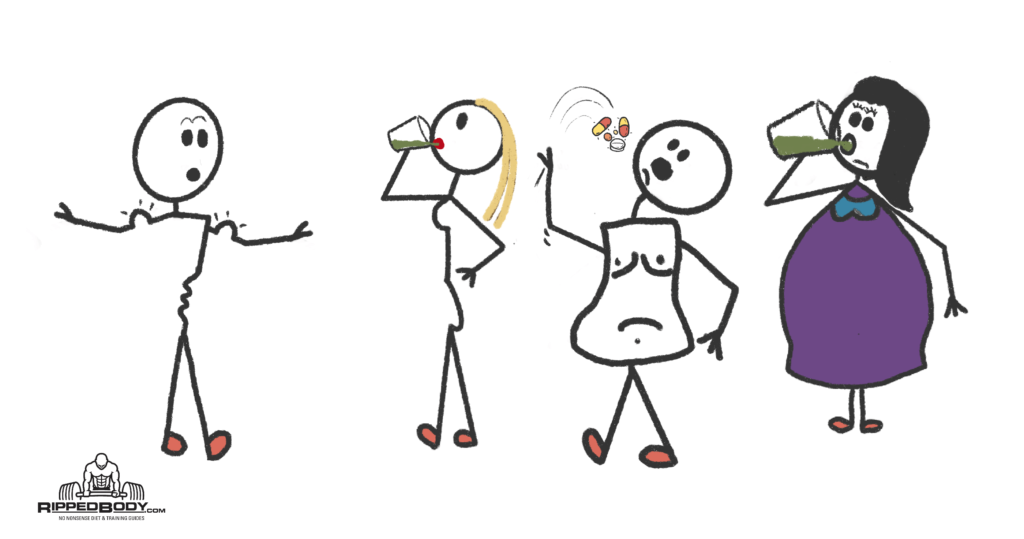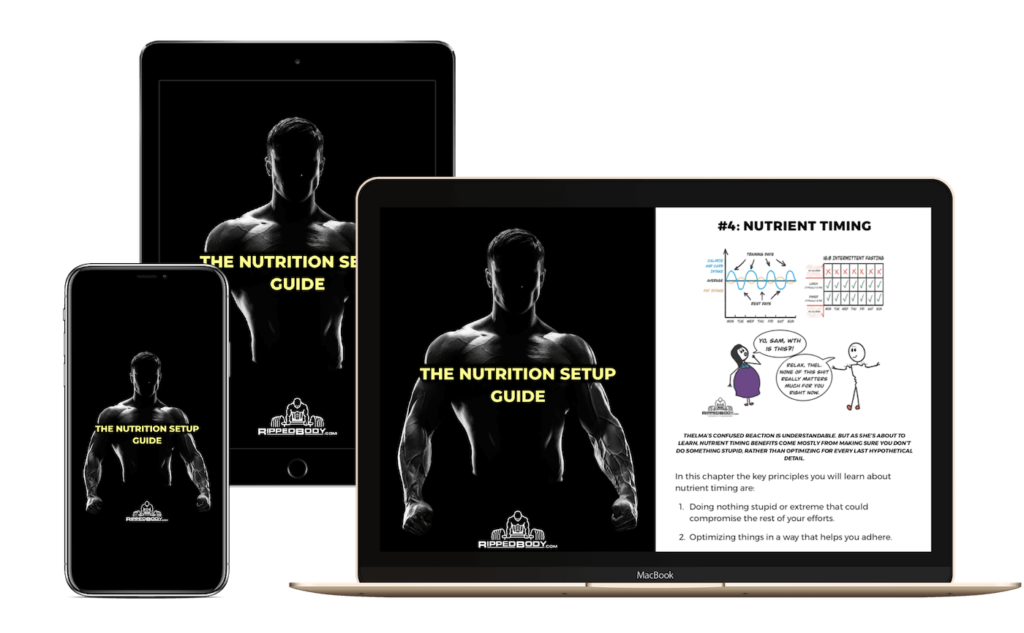#1 Calories, #2 Macros, #3 Micros, #4 Nutrient Timing, #5 Supplements

This is the third chapter in my five-part guide on nutrition for fat loss and muscle growth. Join 100,000 people and download the full PDF version here.
Here are the sections of this chapter:
- Why Micronutrients Are Important
- Fruit and Vegetable Intake Guidelines
- Why Dieters Are At Risk of Micronutrient Deficiencies
- Water Intake Guidelines
WHy MICRONUTRIENTS are important
Micronutrients are generally counted in milligrams (or less).
Think of macros as being the gas in your car, giving it the energy to propel the engine; micros as the oil and lubricants, keeping the car from breaking down.
Long-term micronutrient deficiencies will impact your health and sabotage your training efforts. But, by observing a few simple rules of thumb regarding your daily fruit and vegetable intake, you minimize your risk of deficiencies.
The most commonly known micronutrients are the vitamins and minerals that we get from the foods we eat, which we can’t live without.
Other compounds — like phytonutrients and zoonutrients — aren’t considered vitamins or minerals, but can optimize health and prevent disease. They are obtained from the plant and animal foods we eat. We haven’t figured out how to put these in a pill yet, so a daily multivitamin and mineral can not be considered a substitute for a poor diet, only an insurance policy on a good one.
Vitamins are organic and come from once-living things. The fat-soluble ones (A, D, E, and K) are absorbed in the gut, so deficiencies or surpluses (overdoses) build over time. The water-soluble ones are hard to overdose on because they will be passed in the urine. The flip side of this is that they need to be consumed daily.
Minerals are non-organic. Some of these (calcium, sodium, potassium, magnesium, etc.) are needed in greater quantities than others (iron, copper, zinc, etc.). Not coincidentally, things containing the former group (dairy & salty foods for example) taste especially good to us.
- Zinc deficiencies can negatively impact your metabolism.
- Iron deficiencies can negatively impact strength.
- Calcium deficiencies can negatively impact bone health.
There are performance benefits from eating vegetables. Green vegetables (spinach, rocket, and beetroot in particular) have a lot of nitrates. An increase in nitrate intake can elevate plasma nitrate concentration, which can increase the amount of oxygen supplied to muscle tissue, reducing the cost of exercise and improving exercise tolerance.
It’s not a night and day difference, but Popeye was onto something with eating all that spinach, and your mum was right in telling you to eat your vegetables.

FRUIT AND VEGetable INTAKE GUIDELINES
The majority of people reading this will be fine for the micronutrients we get in meat, dairy, and starchy carbs. It’s generally the ones from fruit and veg that clients typically need to pay attention to, as they are the foods most often skipped.
A good starting point is to eat a minimum of two pieces of fruit a day, to make sure you eat a fist-sized portion of fibrous vegetables with every meal, and to vary their intake day-to-day.
However, it’s a good idea to scale your intake based on how much you are eating overall, so I recommend the following for fruit and veg intake based on calorie intake:
Fruit and Vegetable Intake Recommendations Based On Calorie Intake
| CALORIE INTAKE | CUPS OF FRUIT & VEG. EACH DAY |
| 1200–2000 | 2 cups each |
| 2000–3000 | 3 cups each |
| 3000–4000 | 4 cups each |
This uses the US cup measurement system, which is ~250 ml, or the size of a typical coffee mug.
Fiber Intake Guidelines
Fiber is important for gut health and nutrient absorption.
Both too little and too much fiber can be detrimental, but if you’re following the guidelines mentioned and not doing anything unusual with the rest of your diet, you’re probably fine.
👉 Current recommendations for fiber intake are 14 g/1000 calories.
Constipation can be a sign that you’re eating too little; loose stools are a sign that you’re eating too much. Adjust accordingly.
If you eat a lot of beans, oats, or high-fiber cereal to hit your carbohydrate numbers, your fiber intake is likely too high. You’d have to consume an extraordinary amount of vegetables for this to be the case. See the comparison table below.
Fiber Content of Fibrous Vegetables vs. Oats and Cereals
| FOODS HIGH IN FIBER | FIBER PER 100 g |
| Asparagus, Broccoli, Cabbage, Cauliflower, Celery, Eggplant, Kale, Lettuce, Onion, Spinach, Zucchini | 1.3–2.9 g |
| Beans | ~5.1 g |
| Bran Flakes | 18 g |
| Oats | 11 g |

Shredded Sam schools Nat, Fred, and Thel.
Eat your vegetables. The fiber helps you poop, they keep you full, they have micronutrients we can’t put into a pill or powder, and there are potential performance benefits.
Why Dieters Are At Risk Of Micronutrient Deficiencies
As calories and macronutrients get lower, it becomes harder to prevent micronutrient deficiencies.
Try to maintain dairy and red meat intake (lean, with the fat trimmed, can fit into almost any diet), and get regular outside sun exposure (not through windows). This should help you avoid calcium, zinc, magnesium, iron, and vitamin D deficiencies. For those who don’t eat meat or dairy, I’ll cover supplements that may be worth considering in that section.
WATER INTAKE GUIDELINES
Water is important for fat loss and performance. I don’t like the idea of setting water intake for people based on body weight, simply because some people sweat more than others, not to mention different climates and activity levels. Therefore, I suggest the following guidelines:
- Aim to be peeing clear by noon.
- Have five clear urinations a day.
- Make sure that you’re not dehydrated at the time of your workouts or they will be negatively impacted.
- Taper water intake toward the end of the day as needed so you don’t have to wake to pee.
Thank you for reading. Got a question? Hit me up in the comments.
– Andy
DOWNLOAD THE FULL VERSION OF THIS GUIDE!

I’ll send you the book, our Ripped Body Training Programs, and a 15-day kickstart course on how to put it all together without making the most common progress-killing mistakes. 👇

Privacy policy.